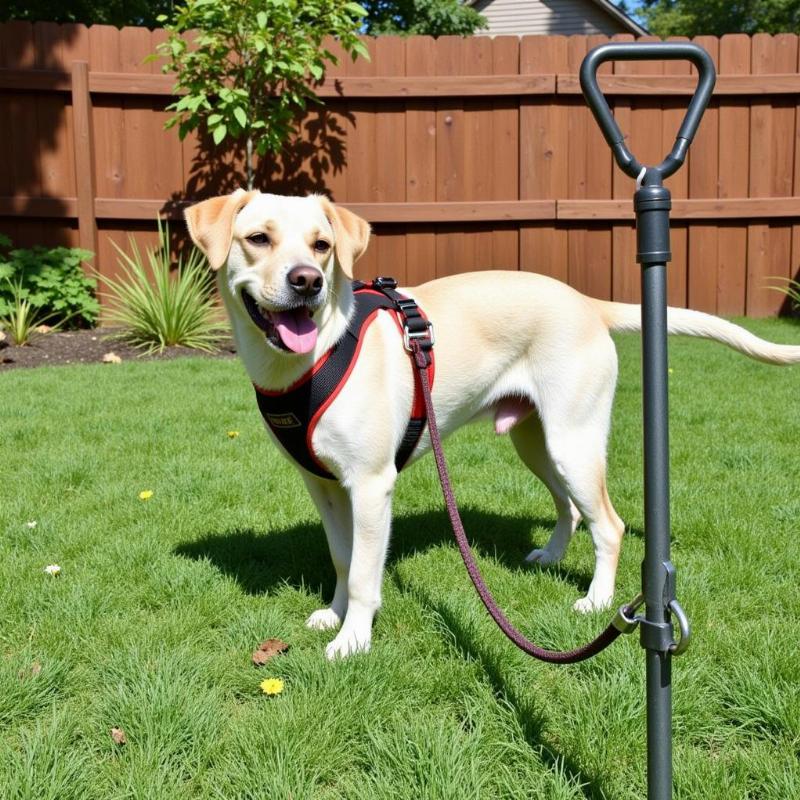Tie-out cables offer a convenient way to give your dog some outdoor freedom while maintaining a safe and controlled environment. However, using a tie-out cable responsibly is crucial for your dog’s well-being and safety. This guide provides essential information on choosing the right tie-out cable, proper usage, and potential hazards to avoid, ensuring a positive experience for both you and your furry friend.
Choosing the Right Tie-Out Cable
Selecting the appropriate tie-out cable depends on several factors, including your dog’s size, breed, temperament, and the environment where it will be used. For smaller dogs, a lightweight tie out cable for small dogs is recommended. A durable and heavy-duty tie-out cable is necessary for larger, more powerful breeds. The length of the cable is also important; it should be long enough to allow your dog to move around comfortably, but not so long that it can reach potential dangers like roads or other animals. Avoid chains, as they can be heavy and uncomfortable for your dog. Opt for coated steel cables or nylon ropes, which are lighter, more durable, and less likely to cause injury.
Safe and Responsible Tie-Out Cable Usage
While tie-out cables can be useful, they should never be used as a permanent solution for confining your dog. They are best used for short periods under supervision, allowing your dog to enjoy fresh air and exercise. Always supervise your dog while it’s on a tie-out cable to prevent entanglement, chewing on the cable, or encounters with other animals. Ensure the area is free of hazards like sharp objects, toxic plants, or standing water. Securely attach the tie-out cable to a sturdy dog tie out stake for large dogs designed specifically for this purpose. Never attach the cable directly to your dog’s collar, as this can cause choking or other injuries. Use a swivel clip and a properly fitted harness to distribute pressure evenly and prevent injury.
Potential Hazards and Precautions
Improper use of tie-out cables can lead to several hazards. One major concern is entanglement, which can restrict your dog’s movement and even cause strangulation. Regular checks of the tie-out area and cable can help mitigate this risk. Another potential danger is chewing on the cable, which can lead to ingestion of metal fragments or other harmful materials. Choose chew-resistant cables and provide your dog with alternative chew toys to keep them occupied.
 Using a Tie-Out Cable Safely
Using a Tie-Out Cable Safely
Tie-Out Cable Alternatives
Consider alternatives like dog runs or fenced areas that offer more freedom and exercise opportunities. Doggy daycare or hiring a dog walker can provide social interaction and physical activity for your dog.
What type of tie-out cable is best for my dog?
The best type of tie-out cable depends on your dog’s size, breed, and temperament. Consult with a veterinarian or pet professional for personalized recommendations.
How long should I leave my dog on a tie-out cable?
Tie-out cables should be used for short periods under supervision, never as a permanent confinement solution.
Are tie-out cables safe for puppies?
Puppies require close supervision and should not be left unattended on a tie-out cable.
Can I use a regular leash as a tie-out cable?
Regular leashes are not designed for tie-outs and can easily break, posing a safety risk.
What should I do if my dog becomes entangled in the tie-out cable?
Stay calm and approach your dog cautiously, untangling the cable as quickly and safely as possible. If you cannot untangle the cable, contact animal control or a veterinarian for assistance.
Where should I attach the tie-out cable?
Attach the cable to a sturdy tie out stake for large dogs specifically designed for this purpose.
Are there any regulations regarding the use of tie-out cables?
Check with your local authorities for specific regulations regarding tie-out cable usage in your area.
In conclusion, tie-out cables can be a useful tool when used responsibly and with your dog’s safety in mind. Choosing the right cable, using it appropriately, and being aware of potential hazards are crucial for a positive experience. Remember, a small dog tie out cable will have different needs than a larger dog’s tie out cable. A tie out chain for dogs is not recommended.
Beautdogs.us is your one-stop resource for all things dog-related in the US. We provide expert advice on dog breeds, care, and products, empowering both new and experienced dog owners to provide the best possible care for their canine companions. From finding the right tie out stake for large dogs to understanding the nuances of various breeds, Beautdogs.us is here to help. Contact us for personalized support at [email protected] or call us at +1 501-555-7529.